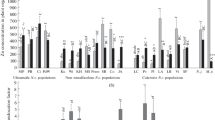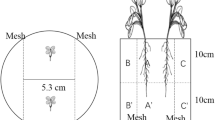Abstract
This study used co-cultivated plants as a bioassay to test the hypothesis that the roots of the zinc-hyperaccumulating plant Thlaspi caerulescensmobilize Zn from less-available pools in the soil. Thlaspi caerulescens was grown in uncompartmentalised pots, or pots that were divided by solid or mesh barriers to limit the extent of root intermingling (rhizosphere interaction) with co-cultivated Thlaspi arvense or Festuca rubra. Thlaspi caerulescens did not increase the concentration of Zn in either indicator species, suggesting that T. caerulescens does not strongly mobilize Zn in its rhizosphere. The increase in the shoot mass of T. arvense when its roots were permitted to intermingle with those of T. caerulescens was explained by greater intensity of competition of T. arvense compared to T. caerulescens.
There was no effect of co-cultivation with T. caerulescens on the shoot biomass of F. rubra. Despite the absence of increased Zn-availability to the co-cultivated species, the mass of Zn accumulated by T. caerulescens was 3-times greater than the mass of Zn depleted from the pool of extractable-Zn in the soil, measured by extraction with 1 M ammonium nitrate. The results are consistent with the hypothesis that the rapid Zn-uptake systems in the roots of T. caerulescens deplete the soluble-Zn at a rate equal to, or faster than that at which Zn is replenished to the soil solution via plant/microbially mediated mobilization or the Zn-buffering capacity of the soil.
Similar content being viewed by others
References
Baker A JM, McGrath S P, Reeves R D and Smith J A C 2000 Metal hyperaccumulator plants: a review of the ecology and physiology of a biological resource for phytoremediation of metal-polluted soils. In Phytoremediation of Contaminated Soil and Water. Eds. N Terry and G S Bañuelos. pp 85–107.CRC Press, Boca Raton, USA.
Brown S L, Chaney R L, Angle J S and Baker A J M 1994 Phytoremediation potential of Thlaspi caerulescens and bladder campion for zinc-and cadmium-contaminated soil.J. Environ. Qual. 23, 1151–1157.
Casper B B and Jackson R B 1997 Plant competition underground. Ann. Rev. Ecol. Sys.28,545–570.
Hajar A S M 1987 The comparative ecology of Minuartia verna L. and Thlaspi alpestre L. in the Southern Pennines, with special reference to heavy metal tolerance.Ph.D. Thesis, University of Sheffield, UK.
Hinsinger P and Jaillard B 1993 Root-induced release of inter-layer potassium and vermiculization of phlogopite as related to potassium depletion in the rhizosphere of ryegrass.J. Soil Sci. 44, 525–534.
Hinsinger P, Elsass F, Jaillard B and Robert M 1993 Root-induced irreversible transformation of a trioctahedral mica in the rhizosphere of rape.J. Soil Sci.44,535–545.
Hutchinson J J, Young S D, McGrath S P, West H M, Black C R and Baker A J M 2000 Determining uptake of ‘non-labile’ soil cadmium by Thlaspi caerulescens using isotopic dilution.New Phytol.146,453–460.
Knight B, Zhao F J, McGrath S P and Shen Z G 1997 Zinc and cadmium uptake by the hyperaccumulator Thlaspi caerulescens in contaminated soils and its effects on the concentration and chemical speciation of metals in soil solution.Plant Soil197, 71–78.
Krämer U, Smith R D, Wenzel WW, Raskin I and Salt D E 1997 The role of metal transport and tolerance in nickel hyperaccumulation by Thlaspi goesingense Halácsy.Plant Physiol.115,1641–1650.
Küpper H, Zhao F J and McGrath S P 1999 Cellular compartmentation of zinc in leaves of the hyperaccumulator Thlaspi caerulescens.Plant Physiol.119,305–311.
Lasat M M, Baker A J M and Kochian L V 1996Physiological characterization of root Zn2+ absorption and translocation to shoots in Zn hyperaccumulator and nonaccumulator species of Thlaspi. Plant Physiol. 112,1715–1722.
Lasat M M and Kochian L V 2000 Physiology of Zn hyperaccumulation in Thlaspi caerulescens. In Phytoremediation of Contaminated Soil and Water. Eds. N Terry and G S Bañuelos. pp 85–107.CRC Press, Boca Raton, USA.
Lloyd-Thomas D H 1995 Heavy metal hyperaccumulation by Thlaspi caerulescens J. and C. Presl. Ph.D. Thesis, University of Sheffield, UK.
Lorenz S E, Hamon R E, Holm P E, Domingues H C, Sequeira E M, Christensen T H and McGrath S P 1997 Cadmium in plants and soil solutions from contaminated soils.Plant Soil 189,21–31.
Marschner H 1995 Mineral Nutrition of Higher Plants.Academic Press Limited, London.
McConnaughay K D M and Bazzaz F A 1991 Is physical space a soil resource?Ecology72,94–103.
McGrath S P and Cunliffe C H 1995 A simplified method for the extraction of the metals Fe, Cu, Ni, Cd, Pb, Cr, Co and Mn from soils and sewage sludges.J. Sci. Food Agric.36,794–798.
McGrath S P, Shen Z G and Zhao F J 1997 Heavy metal uptake and chemical changes in the rhizosphere of Thlaspi caerulescens and Thlaspi ochroleucum grown in contaminated soils.Plant Soil 188, 153–159.
McGrath S P, Sidoli C M D, Baker A J M and Reeves R D 1993 The potential for the use of metal-accumulating plants for the in situ decontamination of metal-polluted plants. In Integrated Soil and Sediment Research: A Basis for Proper Protection. Eds. H J P Eijackers and T Hamers. pp 673–676.Kluwer Academic Publishers, Dordrecht, The Netherlands.
Pence N S, Larsen P B, Ebbs S D, Letham D L D, Lasat M M, Garvin D F, Eide D and Kochian L V 2000 The molecular physiology of heavy metal transport in the Zn/Cd hyperaccumulator Thlaspi caerulescens.Proc. Natl. Acad. Sci. USA 97, 4956–4960.
Persans MW, Yan X, Patnoe J-MML, Kramer U and Salt D E 2000 Molecular dissection of the role of histidine in nickel hyperaccumulation in Thlaspi goesingense (Halacsy).Plant Physiol.121, 1117–1126.
Shen Z G, Zhao F J and McGrath S P 1997 Uptake and transport of zinc in the hyperaccumulator Thlaspi caerulescens and the nonhyperaccumulator Thlaspi ochroleucumPlant Cell Environ.20, 898–906.
Weast R C 1968 Handbook of Chemistry and Physics.49th Edition. The Chemical Rubber Company, Cleveland, Ohio.
Whiting S N, De Souza M P and Terry N 2001a Rhizosphere bacteria mobilize Zn for hyperaccumulation by Thlaspi caerulescens. Environ. Sci. Technol.35,3144–3150.
Whiting S N, Leake J R, McGrath S P and Baker A J M 2000 Positive responses to Zn and Cd by roots of the Zn and Cd hyperaccumulator Thlaspi caerulescens.New Phytol.145,199–210.
Whiting S N, Leake J R, McGrath S P and Baker A J M 2001c Zinc accumulation by Thlaspi caerulescens from soils with different Zn availability: A pot study.Plant Soil.236,11–18.
Zar J H 1999Biostatistical Analysis. Prentice Hall, USA. Section editor: P. Ryan
Author information
Authors and Affiliations
Rights and permissions
About this article
Cite this article
Whiting, S.N., Leake, J.R., McGrath, S.P. et al. Assessment of Zn mobilization in the rhizosphere of Thlaspi caerulescens by bioassay with non-accumulator plants and soil extraction. Plant and Soil 237, 147–156 (2001). https://doi.org/10.1023/A:1013365617841
Issue Date:
DOI: https://doi.org/10.1023/A:1013365617841




